#vdlr – The waterfront in Dun Laoghaire wears its history lightly. In observing it, you're immediately aware of the elegant pavilions which are the classically-designed premises of the three senior yacht clubs, places which are redolent of a long history. But because there is so much in the way of boats and sailing sharing the space with them, and bringing the harbour waters so brightly to life, these are not brooding edifices setting a sombre mood on all about them.
On the contrary, they're fun places, brimming with vitality. They speak of living in the present, even as they acknowledge their interesting past. And as their history has been intertwined with the history of Ireland for almost two centuries, perhaps it would be useful for the rest of the country to realise just how skillfully Dun Laoghaire's yacht clubs have steered themselves through times good and bad. For they've come through national changes which, you might think, would have swept away the clubs and much of what they represented. Yet now they are happily accepted as an integral part of the community, playing a key role in the life of one of Ireland's most vibrant regions, and functioning at a sporting level which gives them national and international significance.
With all four clubs combining in the four day Volvo Dun Laoghaire which starts next Thursday with summer settling in nicely in time on Dublin Bay, the importance of their shared role comes centre stage. But this past week, we highlighted the achievement of one club in particular, when the Mitsubishi Motors/ISA Sailing Club of the Year trophy was formally presented to the Royal St George Yacht Club on Wednesday evening.
Though its title is Club of the Year 2013, it's awarded for success in 2012, and it was first announced in March. However, clubs have their private side and their public side, and the presentation of the ship's wheel trophy (which has been part of the sailing scene since 1979) in the club's own premises makes the award complete, as it's an opportunity to celebrate the contribution made by all members to a club's success.
In fact, in the case of the George, it was people from all over Ireland who contributed to the success, as they volunteered to help with the main feature of the 2012 season, which was the Royal St George YC's position as the lead club in organizing the ISAF Youth Worlds in Dun Laoghaire in July. It was a massive effort, happily crowned with success and international praise. It was led by a formidable team in which Brian Craig managed to be a hands-on Chairman yet with a formidable talent for skillful delegation, so much so that on Wednesday night it was suggested he should write the definitive Delegation Manual. He shouldn't find the actual writing too onerous, as he could delegate that too.
But we could be sure he would do it in precisely the right way, for the thing that really impressed the adjudicators was the thoughtful way in which the George's ISAF team went out of their way afterwards to thank their many voluntary helpers, and to make sure they knew their efforts were truly appreciated. The club set a benchmark in organisational good manners which could be usefully emulated in every walk of Irish life.
However, there's much more to running a successful club than simply hosting events. The adjudicators look to sailing success by members as well, and in 2012 for the Royal St George it was Commodore Martin Byrne who set the pace – in his first year he had won the Edinburgh Cup in the International Dragons (first won by a George member with Jimmy Mooney in 1953), and in 2012 he was top skipper in the entire Irish Dragon class.
As for encouraging youthful talent, the George is almost notorious for its skill in recruiting the new sailors who come to Dublin from all parts of the country. The club goes out of its way to encourage university racing, and when UCD won the Irish title in March, and with it the right to represent Ireland in the Student Yachting Worlds in France in October, it was members of the George who pulled out all the stops to ensure that the UCDSC squad had the necessary boats and facilities to train for this major international event in which they were runaway winners.
And yet all this was happening under the umbrella of a club which can trace its history back to 1838. When the 900 delegates arrived in Dun Laoghaire for the International Sailing Federation's Annual Conference in November, those who had heard of the success of the ISAF Youth Worlds, but hadn't previously been to the venue, were surprised to find that at the heart of it is a stately clubhouse and an organisation going back 174 years.

Le Grand Fromage. The Marquis of Conyngham was the Royal St George YC's first Commodore
The club's extraordinary history, and its intertwining with the national story, was equally surprising for the visitors to grasp. After all, here was an organisation successfully reaching out to young sailors from every corner of the globe. Yet it was doing so from a clubhouse which, once upon a time, had been the almost exclusive preserve of the arrogant offspring of Cromwellian land-grabbers.
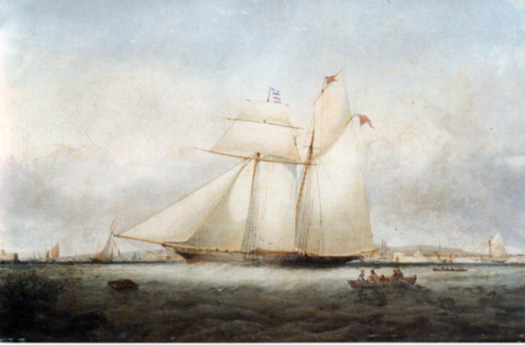
The Marquis of Conyngham's schooner Constance in the harbour, 1855.
Indeed, the membership was so extensively drawn from the wealthy land-owning classes that at one stage around the 1870s, the total tonnage of the large yachts owned by Royal St George YC membership rivalled those of the Royal Yacht Squadron itself. Yet further to complicate the story, the conference in the early 1900s which set in place the Land Commission which was to end the dominance of the Ascendancy landlord class was actually chaired by one of their own, Lord Dunraven, a member of the Royal St George YC since the mid 1880s.
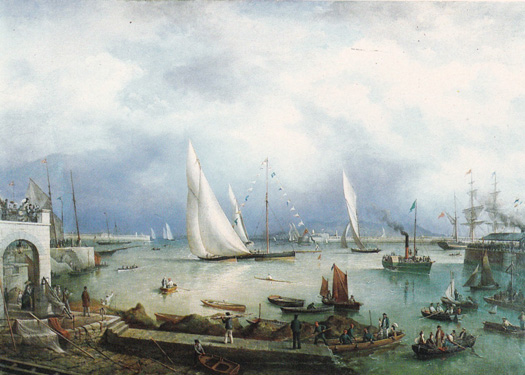
The rare ould times. Royal St George YC Regatta in 1871, when the tonnage of the club's fleet of yachts was exceeded only by the fleet of the Royal Yacht Squadron.
So it's a club which knows when to move on as much as it is aware of the need to acknowledge its rich and colourful history. Certainly it has moved on from membership dominance by a certain kind of yachtsman. The first Commodore was the Marquis of Conyngham, and he was succeeded by others of similar style. But these days, with a greatly expanded clubhouse and the most modern sailing facilities, the flag officers are more likely to acknlowledge descent from remote princes of Breffni, and wild chieftains of the ancient Wicklow hills.
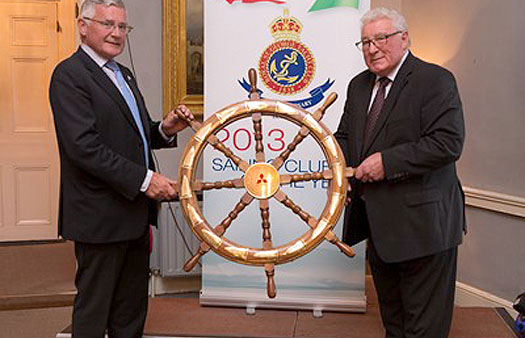
Sailing Club of the Year 2013. RStGYC Commodore Liam O'Rourke (left) receives the trophy from Frank Keane, Chairman of Mitsubishi Motors Ireland.
The names may have changed, but the sailing goes on more busily then ever, and the club is rightly making much of its 175th Anniversary this year. Commodore Liam O'Rourke is leading his members in a programme in which the Volvo Dun Laoghaire Regatta will be the season's highlight, and the George's own special contribution will be hosting the finish of the first stage of the Clyde Cruising Club's Blue Water Trophy Race, which started from Troon in Scotland last night, with the leaders expected in Dun Laoghaire tonight and tomorrow.
This will be bringing a significant contingent of Scottish boats south with many of them then lining up to take part in the VDLR, where the total entry at close of the list at midnight Thursday was 377 boats, including more than 120 visiting ones. Yet any overview of the entry list for this year's Regatta from Thursday 11th July to Sunday 14th July, suggests a new maturity, a sensible coming-of-age. Organisers and participants alike are accepting the social limitations imposed by the fact that most participants will be sailing from their home port. It's one very suburban seafest. And the reality of several years of global recession, biting harder in Ireland than most other places, means that the excitement of completely new boats making their spectacular debut will be conspicuous by its absence.
In looking at the lineup and considering the spirit of the event generally, one word springs irresistibly to mind. This is an unpretentious regatta. Not in any derogatory sense, we hasten to add. It's just that times are tough, so it's simply a case of keeping the head own, and making the best of things. And once you've accepted that, then things aren't so bad after all. There are stacks of boats about, just waiting to be sailed. And though some top crews have left Ireland as economic emigrants (Australian sailing has become even noisier these past two years), there are still plenty of good sailors about. And thanks to the boom years, facilities are better than ever – so let's get out there, and use them.
The result is an entry list pushing towards 380 boats, with an interesting spread which sees the local fleets putting on their best show, while the intriguing array of visiting boats is drawn almost entirely from the Irish Sea/St George's Channel and the North Channel/Clyde areas, with some gallant supporters from the improving facilities in South Wales.
But if you're expecting significant numbers from Ireland's self-styled capital of sailing, good old Cork, well, as they'd say in Manhattan – fuggedaboudid. There's just former Helmsman's Champion of Ireland Stefan Hyde with his J/24 Nyah, and that seems to be it for the Rebel County. But thanks to the marvellous new road from Galway, they too have one representative, the appropriately-named Corby 25 Tribal (Liam Burke). Otherwise, the visitors come sailing from as far away as Coleraine and the Clyde to the north, and Swansea to the far southeast, plus virtually all ports in between.
Clyde sailors have a happy history of involvement with Dun Laoghaire regattas, and they are well-represented in the good turnouts in IRC 0 and IRC 1. It was the most telling indication that recession was upon us when the new First 40, successor to the great First 40.7, made her debut with first and second overall in the 2010 Sydney-Hobart Race. For not one has yet been seen in Irish ownership. But thanks to Clyde Cruising Club skipper Christine Murray, we'll have a chance to see her new First 40 Elf Too in action in Class 0 in Dublin Bay.
Lined up against her will be regular contender Richard Fildes from Abersoch with his Corby 37 Impetuous, and the Howth duo of Alan Chambers and Nobby Reilly with their Mills 36 Crazy Horse, while the home fleet has George Sisk's Farr 42 WOW leading the charge in a comprehensive turnout of a dozen IRC 0 boats.
With 18 boats, IRC 1 has a particularly good representation from the North Wales/Liverpool fleets. And like IRC 0, it has more visitors than locals, so Dublin Bay star Paul O'Higgins with his Corby 33 Rockabill V will be on his mettle to defend the honour of Leinster against visiting dominance.
IRC 2 will provide a sporty start with 25 entrants, 15 of them non-Dun Laoghaire boats. Top of the list is Dave Cullen's 30-footer King One from Howth, which was the Half Ton World Champion under the command of Paul Elvstrom a very long time ago. But there's life in the old King yet – last year she was top boat in Kent in Ramsgate Week, which has become a happy hunting ground for the Cullen crew. Another hot former Half Tonner is Nigel Biggs' Checkmate XV, which has strong North Wales and Cowes connections interwoven with her Dun Laoghaire/Royal St George YC links, while the Brian Cusack team from DLMYC are also into the vintage Half Ton scene with Dick Dastardly.
With 32 boats drawn from 19 different clubs, IRC 3 tops the variety stakes in every way, and includes such classics as the She 31B She Too from Abersoch and the Nich 31 Saki from Dun Laogahaire. Last season, Vincent Gaffney from Howth moved up a couple of feet by changing his successful 26ft Albin Express Alliance for Alliance II, a rare breed Laser 28 with which he has been getting in the frame, definitely a boat to watch, particularly if lighter airs dominate the regatta.
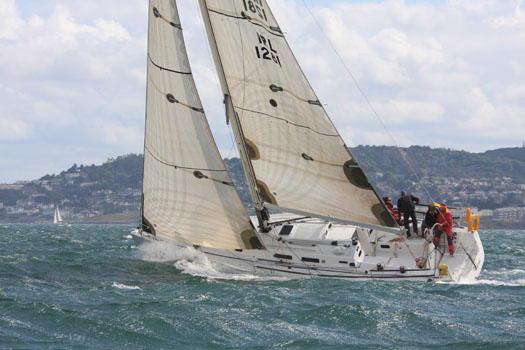
The J/109 has settled in very well as one of the VDLR's premier classes. Photo: Gareth Craig
Dublin Bay is of course the home of One Design racing. When the J/109 made her debut some years ago, sage observers reckoned that here was the perfect boat for a new Dublin Bay OD class. The J/109 has been there or thereabouts as an established class in the bay for a while now, and they certainly make their mark in ISORA racing. But a solid turnout of 14 boats from both sides of the Irish Sea for VLDR 2013 is just the vote of confidence these attractive boats deserve, and this will be one of the hottest fleets with current ISORA Champion Sgrech (Stephen Tudor, Pwllheli SC) very much the boat to beat.
With 16 boats, the growing strength of the First 31.7s is evidence of continuing enthusiasm for one design racing, and recognition of good value for money. Admittedly in the early days of the class, when boats were being bought in Celtic Tiger enthusiasm, the time spreads across the fleet spoke of wildly varying levels of expertise, but things have settled down and there's genuine competition, such that the numbers involved now exceed the longer-established Sigma 33s by three boats.
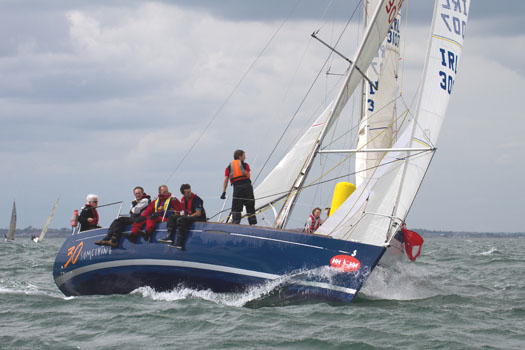
The fleet of First 31.7s now outnumbers the Sigma 33s. Photo: Gareth Craig
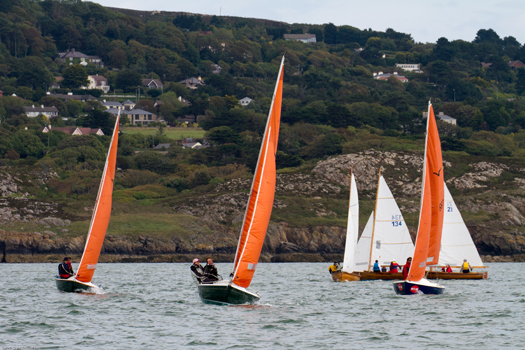
One design classes making the most of this opportunity of four days of intensive racing will include the Squibs and the Mermaids. Photo: Gareth Craig
Older production cruiser-racers sailing as one designs continue to have their adherents, and it's a special year for the Ruffian 23s as 2013 marks their 40th Anniversary, while the Limerick-built Shipman 28s – which should see their 40th in the next couple of years – can still attract a dozen adherents.
There'll be an element of a local derby about the racing for the eight boats in its SailFleet J/80 flotilla, as four will be raced by Northside crews, and four by Southside. We hear no word of any Eastside crew, which would be the pedantic definition of a team from Howth, but doubtless they'll be involved.
Some of the longer-established one design classes are only a shadow of their former selves, but they all have an ability to make come-backs in impressive style. Perhaps the Flying Fifteens are showing us how to do it. They've a solid entry of fifteen regularly raced boats – and every one of them sails from the National YC. The boost of having a single post-race social focus seems to be the secret of success here.
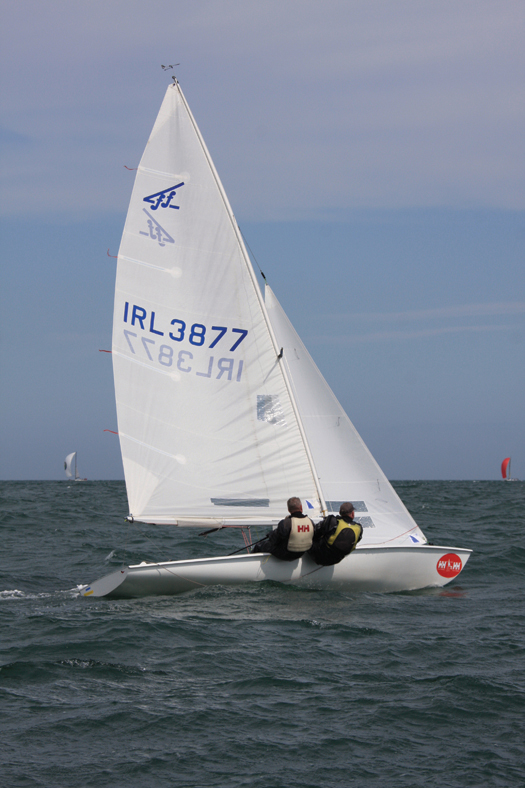
With all owners and crews concentrated in one club, the Flying Fifteens have been thriving as a local one design. Photo: David O'Brien

The classic IDRA 14s make the VDLR a feature of their season Photo: Gareth Craig
We end our preview of VLDR 2013 on an interesting note. A couple of weeks ago, we were enthusing in this blog about the "new Dublin Bay 21" – in other words, the Beneteau First 21 in its several variants, which will be racing as a class in VDLR for the first time this year. At the time, we did a quick trawl of boat sales notices, and found that you could expect to get a reasonable First 21 in the UK or France for between €14,000 and €17,000, which made for an interesting proposition for convenient ready-to-go one design racing in Dublin Bay.
But since then, a 1993 First 210 in Crosshaven has come on the market, advertised on Afloat.ie for €10,500. At that price, she can't be perfect. But heaven knows there's enough boat re-fitting talent around Crosser to get her up and ready to race in Dublin Bay next Thursday, thereby doubling the number of Cork boats racing in VDLR.
It's an interesting challenge. After all, when the new South Coast One Design Class suddenly started hitting the spot down in Cowes in 1956, Max Aitken became enthusiastic and challenged that very fine boatbuilder Clare Lallow, leading builder of the new boats, to build him one within a week. Lallow and his men did it in style. If they could do that from scratch with a timber 26 footer, surely the many talents of Crosshaven could make a slightly tired 21-footer race-ready in three days?































































